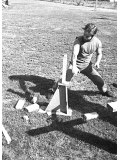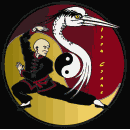
Empty Hand Forms of Hap Ki Do
 My
first exposure to Hap Ki Do was the Billy Jack movies which
showcased the unique talent
My
first exposure to Hap Ki Do was the Billy Jack movies which
showcased the unique talent s of Master Bong Soo Han. The art of
Hap Ki Do, tracing its origins back to monasteries in Korea, had
not yet come to America. Master Han represented our
first glimpse.
s of Master Bong Soo Han. The art of
Hap Ki Do, tracing its origins back to monasteries in Korea, had
not yet come to America. Master Han represented our
first glimpse.
There were no Hap Ki Do schools, and only a handful of teachers could be found in the entire country, primarily servicemen returning from tours of duty in Korea with Black Belt certifications.
My first encounter was meeting James (Jay) Tille (now a retired Chaplain/Captain from the U.S. Army). Master Tille and I were stationed together at Fort Lewis, WA. Back then, martial arts teachers were scarce (compared to today). At the gym, if you saw someone practicing kata, or technique, you immediately hooked up with him or her as a possible training partner, or at least a source for new ideas and inspiration.
Even then, I had been in the arts for many years, which made my first contact with Master Tille especially humbling. We decided to “play” that afternoon and in the course of our sparring session, I threw a right side kick. He dropped unexpectedly to the ground and swept my planted left foot from beneath me. Now I had seen sweeps before, and had learned defenses against them, but this caught me completely unawares. So we continued to play, and I tried to draw the sweep again by throwing another side kick, and again, I was swept. Well, before the afternoon ended, my butt kissed the floor more times than I care to admit.
I insisted on Tille explaining why he was able to sweep me. He went on about there being a “hole” in my position which developed just as I threw the right side kick. According to him, most people had the hole, and Hap Ki Do capitalized on such anomalies. He generously volunteered to share his knowledge and that began a collaboration which lasted for nearly a decade. Tille was Black Belt level or higher in three systems of Hap Ki Do, and was also versed in Hap Ki Do short stick, knife and sword techniques. During our time together, he unselfishly shared the entirety of his knowledge, and eventually ensured (by returning to Korea) that I was fully ranked and certified by his original masters. That’s friendship!
Though there are other resources from which you can glean considerable information on Hap Ki Do, Tille would say that at the end of the day, “Hap Ki Do is everything that is useful.” That was the tenet of our relationship and practice regimen. It is a soft style covering a wide range of martial arts skills and practices. It incorporates an encyclopedia of kicking techniques, thousands of self defense, joint lock, pressure point and throwing techniques, weapons training, and sophisticated concepts of meditation, healing and philosophy.
Though there are common threads to all systems of Hap Ki Do, there are also clear distinctions from once school to another. One system incorporates Kata or Hyung as a cornerstone of training. Another has none. One system includes an extensive regimen of sword training. Another does not. One system might emphasize stances, and employ Ki Hap (Kiai). Another will have no formal stance training (trusting stances will develop spontaneously within the context of fluid motion), and will execute in silence. The quirks and peculiarities abound.
Having said that, there is also a universal consistency among exponents of the art. Whatever their background, all possess a unique understanding and mastery of the subtle. They embody the principles of Circular Energy, Non Resistance, and the Water Principle. These three pillars are the foundation for all Hap Ki Do and permeate all of its teachings, regardless of distinctions among the many sub-systems. In the videos accompanying this section, I have presented the White Lotus Sword system (click here to visit), which is founded on Hap Ki Do sword. Here, I’d like to take the opportunity to share the six empty hand Hyung (forms), the sword forms, and some examples of self defense. There are two archival videos, simply click the links below.
I share these knowing that many schools of Hap Ki Do have no forms whatsoever, and may even be surprised to see these. But anyone with experience in Hap Ki Do will quickly identify the unique aspects of the art which radiate from the movements.
A few technical notes. When I first witnessed Master Tille perform the Hap Ki Do forms, I thought they looked a bit comical. They certainly didn’t have the intense edge of the Japanese and Tae Kwon Do forms, or the complexity of the Kung Fu forms. They also appeared to lack power. Tille explained the forms are teaching models, not performace vehicles. Though appearing simple, they are indeed quite complex, and each presents unique challenges, or “gates” that students must pass through before mastering the more advanced aspects of the art. Previously, I referenced the three pillars of Hap Ki Do (Circular Energy, Non Resistance, and the Water Principle). The forms leave no alternative but for the proponent to completely surrender to the underlying energies of these principles. Check out even the most basic form (Ki Bon Hyung). This is normally taught as four separate components, which are then integrated into the whole. Unlike forms from other styles, the Hap Ki Do form is continuous movement, so much so, that Tille held there is really only one move in an entire form, “You start!.” Once started, you flow through many changes of direction, high and low, foot and hand, until you’re done. The forms are unique in that regard, and in their ability to mold the practitioner into a Black Belt with the unique stamp of Hap Ki Do’s founding principles. As for the power, it’s definitely there, but remember, Hap Ki Do’s strength is its subtlety. Its power is never where you can see it. Its where you can put it to effective use.
Lastly, these forms are believed to be inspired by movements from centuries past, and to have their origins in monastic practices. I can’t say whether or not a proven lineage can be established. I can say I have seen ancient drawings from throughout the orient, and there are clear similarities between these forms, and postures portrayed in those drawings. I have studied Chniese arts, and further note there are threads of relationship with Chinese forms and Tai Chi (given the geographical position of Korea, it would make sense for such connections to exist). I will sometimes do these same forms (particularly Ki Bon Hyung) as though executing Tai Chi.. Indeed the similarity is striking. Finally, you may find the forms don’t necessarily end facing where they started. Simply not required. That’s Hap Ki Do! I had in fact been doing them for years, when I made a personal discovery. If one learns all of the empty hand forms, and executes them in direct succession, the end result will be a continuous extended form, ending precisely where it started. I now believe that was the underlying intent of the masters. Lastly, like the sword forms, these empty hand forms can be strung together in any order or combination to create extraordinarily complex sequences of movement. When you arrive at that level you might perhaps “lose” youself in the never ending form, and forever leave your bad habits behind.
[Home] [About Us
] [Archie] [Concepts] [Contact Us]
[Gun
Fu Manual] [Kata]
[Philosophy] [Sticks] [Stories] [Web
Store] [Terms of Use]
[Video]
Copyright 2000-2025, Mc Cabe and Associates, Tacoma, WA. All rights reserved. No part of this site can be used, published, copied or sold for any purpose, except as per Terms of Use .